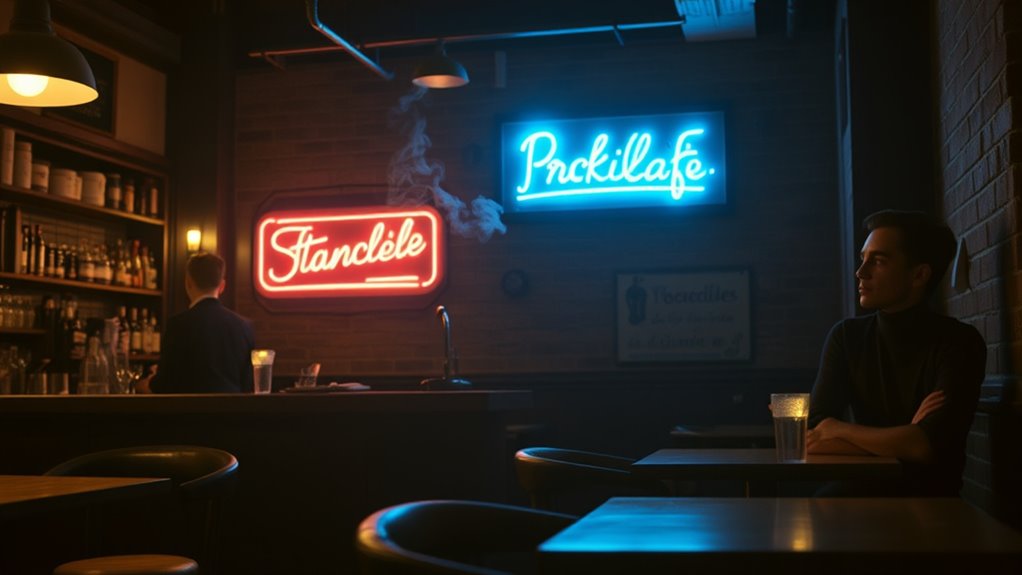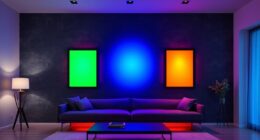Cafés in the French New Wave are more than just settings—they symbolize rebellion, spontaneity, and authenticity. You’ll notice cluttered tables, smoky atmospheres, and lively conversations that challenge traditional film styles. These spaces subtly reflect post-war social tensions and personal struggles, acting as microcosms of French society. By exploring their layered symbolism, you’ll see how atmosphere and detail deepen the movement’s themes of change and experimentation. Keep exploring to uncover even more hidden meanings behind these iconic spaces.
Key Takeaways
- Cafés serve as vibrant spaces for spontaneous interactions that embody the movement’s emphasis on authenticity and improvisation.
- They symbolize rebellion, reflecting societal tensions and offering a microcosm of post-war French culture and social change.
- The cluttered, lively atmospheres create visual shorthand for the chaos and passion characteristic of the French New Wave.
- Dialogues and silences in cafés subtly critique societal norms, adding layers of meaning and subtext to films.
- Cinematic use of cafés emphasizes imperfections and small details, reinforcing themes of spontaneity, experimentation, and personal expression.

Cafés in the French New Wave didn’t just serve as casual meeting spots—they became essential spaces for creative exchange and cinematic experimentation. When you step into these lively venues, you’re entering a hub where ideas flow freely, and filmmakers use the environment to deepen their storytelling. These cafés are far more than simple backdrops; they’re charged with cinematic symbolism that captures the spirit of the era. You can observe how the cluttered tables, cigarette smoke, and spontaneous conversations embody the rebellion and optimism of the movement. These settings symbolize a break from traditional cinema, emphasizing spontaneity, authenticity, and personal expression. As you watch films from this period, you’ll notice that the cafés act as visual anchors, framing characters’ struggles and aspirations amid lively, imperfect atmospheres that mirror the chaotic but passionate nature of the movement. Moreover, the role of attention in creative practice highlights how filmmakers and actors alike focus on small details—such as gestures, timing, and dialogue—to craft authentic moments that resonate with audiences.
More importantly, these cafés serve as platforms for social commentary. When you see characters engaged in animated debates or reflective silences over coffee, they’re often commenting on broader societal issues—alienation, class distinctions, political unrest. The cafés become microcosms of French society, where filmmakers subtly critique prevailing norms through dialogue and ambiance. For example, the bustling, often crowded spaces reflect the vibrancy and turbulence of post-war France, capturing the tension between tradition and modernity. You might notice how the interactions within these cafés reveal underlying social tensions or the desire for change, making the setting itself a form of storytelling. By positioning characters within these lively spaces, filmmakers highlight the societal undercurrents shaping their narratives, inviting you to interpret the subtext beneath everyday conversations.
As you observe, you’ll find that the cafés also serve as a symbolic bridge between characters and the audience. They create an intimate yet dynamic environment where personal and political issues intertwine, encouraging you to see beyond the surface. These spaces allow filmmakers to comment subtly on social stratification or cultural shifts without overt preachiness. They’re a visual shorthand for the complexities of French society, layered with meaning that invites your interpretation. In essence, the cafés of the French New Wave aren’t just settings—they’re active symbols of change, rebellion, and reflection. Through cinematic symbolism and social commentary, they help you understand the movement’s core ideals: a break from convention, a celebration of spontaneity, and a willingness to explore the deeper truths beneath everyday life. Additionally, the emphasis on attention and the acceptance of failure as a learning process in creative practice are reflected in the improvisational style and often unpolished aesthetic of films from this era, highlighting how embracing imperfections can enhance authenticity.
Frequently Asked Questions
How Did Cafés Influence the Narrative Style of French New Wave Films?
You see cafés shape the narrative style of French New Wave films by serving as symbolic spaces for dialogue and reflection. They often symbolize freedom and social connection, while also enabling narrative fragmentation through spontaneous conversations and jump cuts. This approach immerses you in characters’ lives, emphasizing realism and spontaneity. Cafés become dynamic settings where symbolism and fragmented storytelling intertwine, creating a unique, layered cinematic experience.
Which Specific Cafés Were Iconic Filming Locations for French New Wave Directors?
Like a painter choosing his palette, you’ll find iconic cafés such as Café de Flore and Les Deux Magots as the backdrop for French New Wave films. These spots embody authentic café aesthetics and inspire innovative filming techniques. As a director, you harness their vibrant atmosphere to evoke spontaneity, capturing the essence of Parisian life. Their gritty charm becomes a silent character, shaping your story’s energy and visual style.
You see how coffee culture during the French New Wave mirrors social transformation, reflecting a shift towards more casual, open conversations. Cafés became hubs for young filmmakers and thinkers, challenging traditional norms and embracing new ideas. This social change fostered creativity, spontaneity, and rebellion, making cafés a symbol of the era’s cultural awakening. Your involvement in this scene highlights how everyday spaces can influence broader societal shifts.
Were There Any Recurring Characters or Themes Associated With Cafés in These Films?
Cafés in these films are like recurring stages for characters and themes. You’ll notice recurring characters, such as young rebels or introspective artists, often meeting in cafés to discuss life, love, or politics. Thematic motifs like fleeting time, existential questioning, and youthful rebellion frequently surface in these settings. These cafés serve as lively hubs where characters’ personalities and ideas intertwine, highlighting the era’s dynamic social and artistic shifts.
How Did the Visual Depiction of Cafés Differ Among Various French New Wave Directors?
You notice that different French New Wave directors depict cafés uniquely through cinematic framing and color palettes. Godard often uses tight, dynamic shots with high contrast black-and-white, emphasizing spontaneity. Truffaut favors warm color palettes and softer framing, creating intimacy. Resnais employs more experimental framing and muted tones, adding a reflective mood. These visual choices reflect each director’s style, shaping how audiences experience the cafés’ social and emotional layers.
Conclusion
As you step back into the bustling cafés of the French New Wave, you realize they’re more than just coffee and chatter—they’re the beating heart of rebellion and romance. These lively spaces are like cinematic crossroads, where style and subtext dance in shadows and sunlight. You carry their spirit with you, a bittersweet sip of history that whispers secrets of a revolution brewed in every espresso shot and whispered conversation. The cafés, forever etched in film and memory, invite you to listen.









